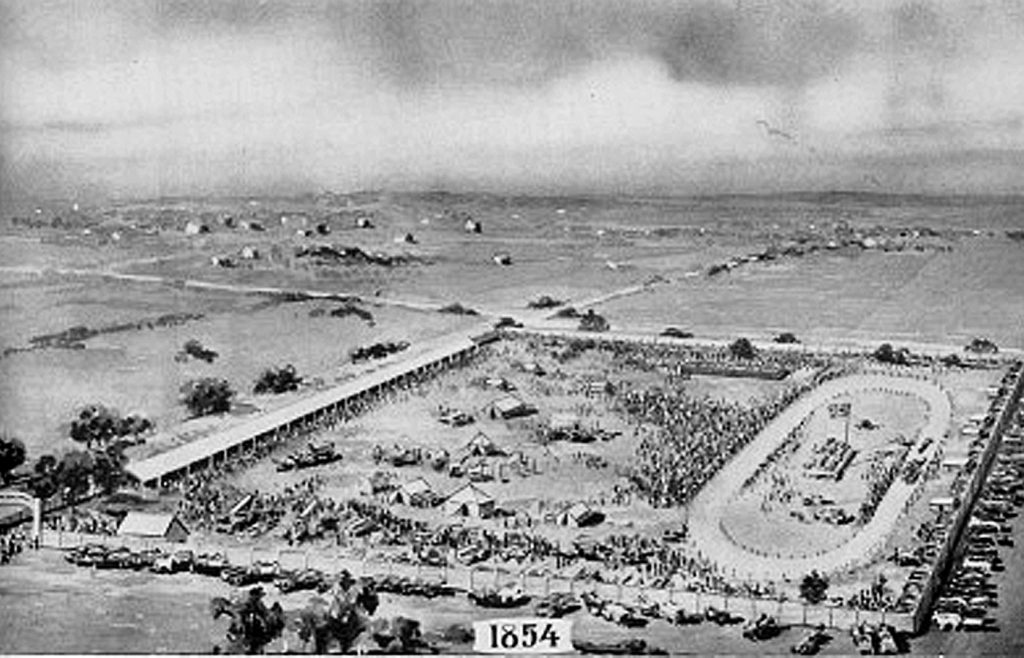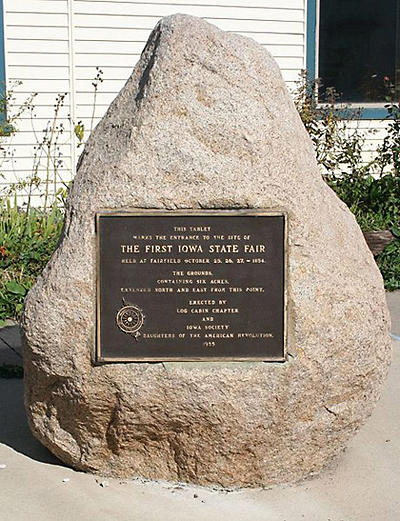
At the 445-acre State Fairgrounds in Des Moines this August, you may see a sign commemorating Iowa’s first state fair, held in Fairfield on October 25–27, 1854. That was four years before the first railroad arrived, so people came on foot or on horseback, by stagecoach or by wagon. The Kansas-Nebraska Act had just obliterated the Missouri Compromise; immigrants would now determine whether Kansas would be slave or free, and many fair participants had ties to this conflict that presaged the Civil War.
The Secretary of the first Iowa State Fairs was Dr. Joshua Monroe Shaffer, who had moved to Fairfield in 1852. His brother John had taught him medicine in Washington, Pennsylvania, after studying under Dr. F. Julius LeMoyne, a prominent abolitionist who sheltered slaves escaping on the Underground Railroad. Dr. J. M. Shaffer also opposed slavery. A member of the pro-Lincoln “Wide-Awake Club” of 1860, he was elected Republican State Senator in 1862, replacing James F. Wilson, who had been elected to Congress.
Admission to the first State Fair cost 25 cents, and 7,000 to 10,000 visitors attended the six-acre grounds north and east from the entrance at what are now Fourth and Grimes Streets. Lee County citizens opened the fair by presenting a 360-pound “great Denmark Cheese” to Iowa’s own “big cheese,” Free Soil Party Governor-elect James W. Grimes, who quickly and skillfully brought Iowa into the new Republican Party, founded to prevent the spread of slavery.
Though primarily showing Iowan goods—including cattle, oxen, horses, mules, sheep, swine, poultry, farm implements, produce, cloth, prepared foods, artwork, and inventions—the fair also attracted first-rate contestants from across the country. Benjamin C. Perkins brought his sheep some 560 miles from Rochester, Ohio, to Fairfield and won awards for them. Benjamin’s cousin Simon Perkins was the wool-dealing partner of the famous abolitionist John Brown; abolitionists often preferred wool to slave-raised cotton. In 1855 John Brown first traveled through Iowa, perhaps even through Fairfield, on his way to Kansas, where he fought Missouri’s “Border Ruffians” in the country’s first armed clash over slavery. Another of Benjamin’s cousins was Thomas Perkins, whose sister-in-law Harriet Beecher Stowe wrote Uncle Tom’s Cabin, and whose brother-in-law Henry Ward Beecher raised money to arm Free Soil settlers in Kansas with rifles smuggled in boxes labeled “Bibles.” John Andrews of Pleasant Plain, a Virginian Quaker, won the prizes for the best long-wooled sheep, and he judged the sheep at the second Iowa State Fair. Perhaps Andrews was also one of the Pleasant Plain Quakers who aided slaves on the Underground Railroad.

The final day of the first Fairfield fair featured the main attraction: “female equestrianism.” Jefferson County’s Hannah and Cynthia Ball, daughters of abolitionist Joseph Ball, competed with eight other Iowa girls for the prize. Belle Turner of Lee County won, but the crowd raised $165 in cash and six month’s school tuition on the spot for the impoverished 14-year-old Eliza Jane Hodges of Iowa City. The spirited contestants were barred the following year from performing stunts.
In 1855, Fairfield’s second Iowa State Fair enclosed seven acres of exhibits and drew as many as 13,000 to 15,000 visitors at a time. The Ball sisters competed unsuccessfully with 15 other equestrians. John Deere from Illinois won both first and second prize for best cultivator, and the committee recommended a diploma to the “neat and curious” Sharps breech-loading rifle manufactured in Hartford, Connecticut. The highly accurate, long-range Sharps rifle was the famous “Beecher’s Bible” weapon of choice for John Brown and New England emigrants to Bleeding Kansas of 1855–56, and was favored by U. S. Army sharpshooters and by the cavalry of both sides in the Civil War.
After Fairfield hosted the first two state fairs in 1854 and 1855, the fair moved to Muscatine (1856–57), Oskaloosa (1858–59), Iowa City (1860–61), Dubuque (1862–63), Burlington (1864–66), Clinton (1867–68), Keokuk (1869–70), Cedar Rapids (1871–73), Keokuk again (1874–75), and Cedar Rapids again (1876–78) before moving permanently to Des Moines.
The name “Fairfield” did not arise from our city’s hosting of Iowa’s first State Fairs; pioneer Nancy Bonnifield had named the town back in 1839—perhaps for its beautiful landscapes, and perhaps for herself, “bonnie” being Scottish for “fair.”
Fairfield residents Rory and Rena Goff enjoy researching the area’s history. Rory Goff has just published a book about Southeast Iowa’s underground railroad, Anti-Slavery and the Underground Railroad in Fairfield, Iowa, available at Revelations Bookstore or Amazon.com.
